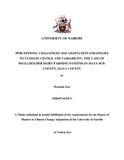| dc.description.abstract | An in-depth understanding of perceptions, challenges and adaptation strategies of Smallholder Dairy Farming Systems (SDFS) is crucial if appropriate interventions to increase adaptive capacities to climate change and variability (CCV) are to be undertaken. This study aims to determine adaptation strategies that have the potential to create resilient SDFS in Siaya Sub-County, Siaya County and probable up-scaling to similar agro-ecological zones. This arises from observations that CCV expressed as frequent droughts and floods is singled out as the main hindrance to agricultural production. The study uses mixed methods approach including household surveys, participatory methods, statistical data analysis and literature review. From the results obtained, it emerged that the climate of the study location had changed with droughts perceived as being the most frequent. Analysis of climate data showed long-term drying of all seasons except SON/D yet SDFS had not changed their planting exposing them to frequent crop failure. Correlation coefficient (r) analysis of rainfall data revealed that annual cumulative rainfall was strongly positively correlated (r>0.5) to JJA and SON/D but weakly positively correlated (r=0.494) to MAM implying MAM contribution to maize, beans, Napier and pasture production was on the wane. MAM/J and MAM had a very strong (r=0.9) positive correlation (p=0.004), while JJA and MAM/J had a weak (r=0.487) positive correlation (p=0.004) implying that the June precipitation strongly contributed to MAM aggregate rainfall effects. Similarly temperatures were perceived to have increased resulting in biome range shifts exhibited by invasive plant species initially associated with hotter regions of the County. Results from a binary longit regression model showed that invasive plant species, temperature, floods, frequency of drought and poor waste management had significant effect on incidences of livestock diseases (p<0.05). Tsetse flies and ticks were identified as major vectors (p<0.05) associated with prevalence and spread of livestock diseases with flare-ups for the former becoming more frequent. Some of the adaptation strategies observed included use of maize stovers as a livestock feed, water from shallow wells and roof catchment, high yielding Napier and pasture grass varieties, regular vaccinations, spraying, and bush clearing. Barriers to adaptation strategies identified and included: institutional barriers through consistent top-down approaches used to initiate and implement programs; out of reach technologies for SFDS; social barriers that impeded flow of related climate information; cultural practices that hindered timely land operation; religious barriers were attributed to some sects burning rearing of pigs and dairy goats that would otherwise enhance livelihoods. This study recommends that: SDFS should enhance adaptive capacities against CCV through diversification of livelihoods by expansion of enterprises to safeguard against asset erosion during times of extreme climate perturbations; multisectoral policies to steer institutions from “Path Dependency” be formulated to get rid of institutional rigidities; mechanisms to timely and adequately fund the sector be instituted; early warning weather system be developed; empirical studies of CCV effects on different fodders be conducted to enable targeted adaptation strategies aimed at increased resilience of SDFS. | en_US |

